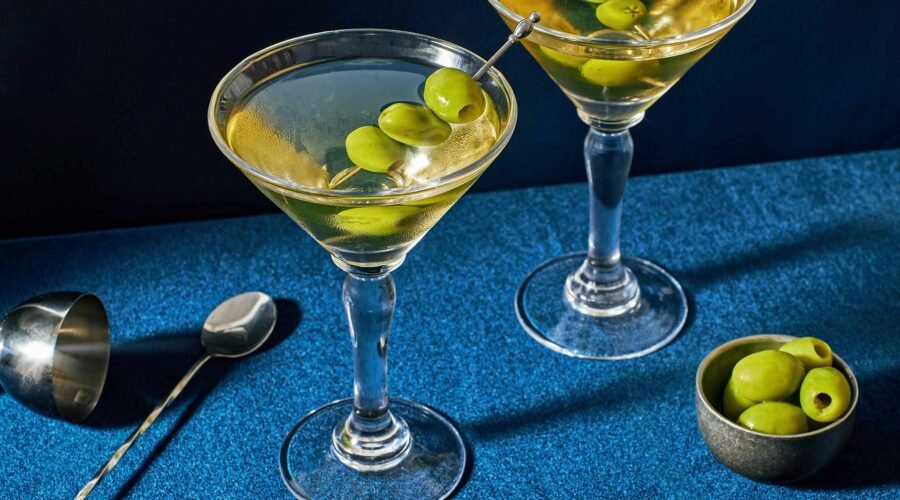The Briny Origins of the Dirty Martini
Forget sugary Appletinis and fruit juice-spiked Mississippi Bourbon Punch. If your drink preferences skew more savory than sweet, the dirty martini belongs in your order queue. With a deep umami kick from a heavy-handed splash of salty olive brine, this cocktail has earned its honored spot in the cocktail canon. Here’s everything you need to know about it.
What Is a Dirty Martini?
Before we go any further, let’s get one thing straight: A martini can’t be dirty unless it’s cut with olive brine, aka the juice from a jar of olives. Brine is defined as water saturated with salt, but depending on your olives, that brine can vary slightly. Other ingredients sometimes include vinegar, monosodium glutamate (better known as MSG), ascorbic acid (that’s vitamin C), citric acid, lactic acid, sodium alginate and more.
A martini, of course, dates to at least the 1880s and has historically been defined as a booze-forward marriage of gin and dry vermouth. Vodka appeared as a gin substitute beginning in the 1930s.
The History of the Dirty Martini
According to the Oxford Companion to Spirits & Cocktails, the practice of adding olive brine to one’s martini has been around since at least 1901. The term “dirty martini” seemingly wasn’t coined until the 1980s.
However, Franklin Delano Roosevelt may have been an early proponent of using olive brine in cocktails. Allegedly, the president “would shake up a drink at the drop of a hat… [and] was reported to have splashed a bite of brine in his drinks at the White House,” writes Robert Simonson in The Martini Cocktail: A Meditation on the World’s Greatest Drink, with Recipes. “Because of this, many have called FDR the author of the dirty martini.”
How to Order a Dirty Martini
Not everyone agrees on how much olive brine belongs in a dirty martini. Some bartenders add only a few restrained drops, while others dump in a heaping, salty glug of it. This is all to say, if you desire a brine-forward dirty martini, ask for heavy pour of olive juice. Want something less salty? Ask for only a splash.
For what it’s worth, we think our recipe below provides the perfect balance of brine and booze.
How to Make a Dirty Martini
Recipe by Jacy Topps
Ingredients
2½ ounces vodka or dry gin
½ ounce dry vermouth
½ ounce of olive brine
3 green olives for garnish
In a cocktail shaker filled with ice, combine all ingredients, except olives.
Stir well, about 20-30 seconds, then strain into a chilled martini glass. (Classic martinis should be stirred, not shaken.)

Garnish with olives.

FAQ
What’s the Difference Between a Dry Martini and Dirty Martini?
In the martini realm, a “dry” martini means that it uses less vermouth in relation to gin or vodka. It doesn’t have anything to do with the addition of olive juice, which is what makes a martini “dirty.” In fact, plenty of folks are partial to a dry dirty martini.
Is a Dirty Martini Better with Gin or Vodka?
This is a matter of taste. A gin martini is generally more botanical in flavor, while often vodka lends the cocktail a smoother, cleaner taste. When you add olive juice to the mix, a dirty gin martini tends to be more complex in flavor, whereas dirty vodka martinis often have a more one-note olive flavor. It’s up to you which is best!
Should a Martini Be Shaken or Stirred?
Despite James Bond’s iconic martini order, which he requests “shaken, not stirred,” our classic martini and other riffs on it are generally stirred, not shaken. (For what it’s worth, the fictional spy’s go-to drink was a Vesper martini, but that’s a whole other subject.)
In The Periodic Table of Cocktails, author Emma Stokes notes that a shaken martini will be more aerated and therefore “appear cloudy when you first make it.” That’s fine if you’re going for that effect, but otherwise, stick to stirring for a clear cocktail.
Also, she continues, a shaken martini “will never result in a martini that is as cold as it’s possible to get a stirred martini,” plus, a shaken martini generally needs to be “double-strained to remove shards of ice.” For all these reasons, many aficionados agree that martinis should be stirred, not shaken.
Published on November 21, 2022


